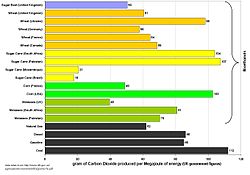
A low-carbon fuel standard (LCFS) is an emissions trading rule designed to reduce the average carbon intensity of transportation fuels in a given jurisdiction, as compared to conventional petroleum fuels, such as gasoline and diesel. The most common methods for reducing transportation carbon emissions are supplying electricity to electric vehicles, supplying hydrogen fuel to fuel cell vehicles and blending biofuels, such as ethanol, biodiesel, renewable diesel, and renewable natural gas into fossil fuels.[2] The main purpose of a low-carbon fuel standard is to decrease carbon dioxide emissions associated with vehicles powered by various types of internal combustion engines while also considering the entire life cycle ("well to wheels"), in order to reduce the carbon footprint of transportation.
The first low-carbon fuel standard mandate in the world was enacted by California in 2007, with specific eligibility criteria defined by the California Air Resources Board (CARB) in April 2009 but taking effect in January 2011.[3][4][5][6] Similar legislation was approved in British Columbia in April 2008,[7] and by European Union which proposed its legislation in January 2007 and which was adopted in December 2008.[8] The United Kingdom is implementing its Renewable Transport Fuel Obligation Program, which also applies the concept of low-carbon fuels.[1]
Several bills have been proposed in the United States for similar low-carbon fuel regulation at a national level but with less stringent standards than California.[9] As of early 2010 none have been approved. The U.S. Environmental Protection Agency (EPA) issued its final rule regarding the expanded Renewable Fuel Standard (RFS2) for 2010 and beyond on February 3, 2010.[10] This ruling, as mandated by the Energy Independence and Security Act of 2007 (EISA), included direct emissions and significant indirect emissions from land use changes.[11][12][13]
- ^ a b "Carbon and Sustainability Reporting Within the Renewable Transport Fuel Obligation" (PDF). Department of Transport, United Kingdom. January 2008. Archived from the original (PDF) on 2016-11-24. Retrieved 2011-10-12.
- ^ "CARB LCFS Data Dashboard".
- ^ Debra Kahn (2009-04-24). "California Adopts Low-Carbon Fuel Standard". Scientific American. Retrieved 2009-05-04. [dead link]
- ^ Cite error: The named reference
SFG042409was invoked but never defined (see the help page). - ^ Cite error: The named reference
NYT042409was invoked but never defined (see the help page). - ^ Cite error: The named reference
CNN0409was invoked but never defined (see the help page). - ^ Cite error: The named reference
Vancouver08was invoked but never defined (see the help page). - ^ Cite error: The named reference
EU08was invoked but never defined (see the help page). - ^ Sperling, Daniel and Deborah Gordon (2009). Two billion cars: driving toward sustainability. Oxford University Press, New York. pp. 194–196. ISBN 978-0-19-537664-7.
- ^ Cite error: The named reference
EPArule2010was invoked but never defined (see the help page). - ^ Cite error: The named reference
EPAdraftwas invoked but never defined (see the help page). - ^ Cite error: The named reference
EPA0509was invoked but never defined (see the help page). - ^ Cite error: The named reference
EPA2010was invoked but never defined (see the help page).